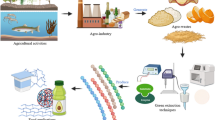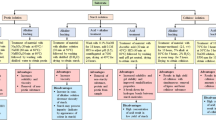Abstract
The scale of agricultural waste is large, including crop residues (the plant waste left in the field after harvest), which retained in the field are responsible for agricultural greenhouse gas emissions. Some of those materials are used for organic fertilizer, soil enrichment, or animal feed, but plenty is still available for other uses. The massive amounts of agricultural waste such as stems, leaves, seeds, pods, and more, which never make it off the farm, are a subject of research to use them as bio-based packaging materials. As concerns about waste and by-products grow, researchers around the world are working to turn those materials into useful products and find new ways of using agricultural waste or other unappreciated materials as a valuable biopolymer. The most remarkable works are focusing on the production of bio-based packaging, which can be an alternative to petroleum-based plastics.
Access this chapter
Tax calculation will be finalised at checkout
Purchases are for personal use only
Similar content being viewed by others
References
Ahmad F, Khan ST (2019) Potential industrial use of compounds from by-products of fruits and vegetables In: Malik A, Erginkaya Z, Erten H (eds) Health and safety aspects of food processing technologies. Springer, Cham, pp 273–307
Alshwal BY, Bala MS, Gupta A, Sharma S, Mishra P (2019) Improved properties of keratin-based bioplastic film blended with microcrystalline cellulose: a comparative analysis. J King Saud Univ Sci 853–857
Amran MA, Palaniveloo K, Fauzi R, Satar NM, Mohidin TBM, Mohan G, Razak SA, Arunasalam M, Nagappan T, Seelan JSS (2021) Value-added metabolites from agricultural waste and application of green extraction techniques. Sustainability 13(20):11432
Andrade RM, Ferreira MS, Gonçalves ÉC (2016) Development and characterization of edible films based on fruit and vegetable residues. J Food Sci 81(2):412–418
Andrade RD, Skurtys O, Osorio FA (2012) Atomizing spray systems for application of edible coatings. Comprehensive Rev Food Sci Food Safety 11:323–337
Barriera JCM, Arraibi AA, Ferreira ICFR (2019) Bioactive and functional compounds in apple pomace from juice and cider manufacturing: Potential use in dermal formulations. Trends Food Sci Technol 90:76–87
Ben-Ohman S, Jõudu I, Bhat R (2020) Bioactives from agri-food wates: present insights and future challenges. Molecules 25:510
Berthet MA, Coussy H, Chea V, Guillard V, Gastaldi E, Gontard N (2015) Sustainable food packaging: valorising wheat straw fibres for tuning PHBV-based composites properties. Compos A Appl Sci Manuf 72:139–147
Berthet MA, Mayer-Laigle C, Rouau X, Gontard N, Angellier-Coussy H (2017) Sorting natural fibres: a way to better understand the role of fibre size polydispersity on the mechanical properties of biocomposites. Composites Part A 95:12–21
Carvalho V, Freitas E, Fradinho J, Reis M, Oehmen A (2019) The effect of seed sludge on the selection of a photo-EBPR system. New Biotechnol 49:112–119
Chan JX, Wong JF, Hassan A, Zakaria Z (2021) Bioplasics from agricultural waste 141–169
Chang I, Im J, Chung M-K, Cho G-C (2018) Bovine casein as a new soil strengthening binder from dairy waste. Constr Build Mater 160:1–9
Cinar SO, Chong ZK, Kucuker MA, Wieczorek N, Cengiz U, Kuchta K (2020) Bioplastic production from microalgae: a review. Int J Env Res Public Health 17(11):3842
Cui J, Zhao C, Feng L, Han Y, Du H, Xiao H, Zheng J (2021) Pectins from fruits: relationship between extraction methods, structural characteristics, and functional properties. Trends Food Sci Technol 110:39–54
Delgado M, Felix M, Bengoechea C (2018) Development of bioplastic materials: From rapeseed oil industry by products to added-value biodegradable biocomposite materials. Ind Crops Products 401–407
Duque-Acevedo M, Belmonte-Urena LJ, Cortes-García FJ, Camacho-Ferre F (2020) Agricultural waste: review of the evolution, approaches and perspectives on alternative uses. Global Ecol Conserv 22:1–23
Eerhart AJJE, Faaij APC, Patel MK (2012) Replacing fossil-based PET with biobased PEF; process analysis, energy and GHG balance. Energy Environ Sci 5(4):6407
Elbersen B, Fritsche UR, Petersen J-E, Lesschen JP (2012) Assessing the effect of stricter sustainability criteria on EU biomass crop potential. Biofuels Biobrod Bioref 7(2):173–192
Esparza I, Jimènez-Moreno N, Bimbela F, Ancín-Azpilicueta C, Gandía LM (2020) Fruit and vegetable waste management: Conventional and emerging approaches. J Env Manag 265:110510
Faria Arquelau PB, Silva VDM, Garcia MAVT, Araujo RLB, Fante CA (2019) Characterization of ediblecoatings based on ripe Prata banana peel flour. Food Hydrocolloids 89:570–578
Fradinho J, Allegue LD, Ventura M, Melero JA, Reis MAM, Puyol D (2021) Up-scale challenges on biopolimer production from waste streams by Purple Phototrophic Bacteria mixed cultures: a critical review. Biores Technol 527:1–12
Galus S, Mathieu H, Lenart A, Debeaufort F (2012) Effect of modified starch or maltodextrines incorporation on the barrier and mechanical properties, moisture sensitivity, and appearance of soy protein isolate-based edible films. Innov Food Sci Emerg Technol 16:148–154
Gervasi T, Pellizzeri V, Calabrese G, Di Bella G, Cicero N, Dugo G (2017) Production of single cel protein (SCP) from food and agricultural waste by using Saccharomyces cerevisiae. Formerly Natural Prod Lett 32(6):648–653
Gontard N, Sonesson U, Birkved M, Majone M, Bolzonella D, Celli A, Angellier-Coussy H, Jang G-W, Verniquet A, Broeze J, Schaer B, Batista AP, Sebok A (2021) A research challenge vision regarding the management of agricultural waste in a circular bio-based economy. Critical Rev Env Sci Technol 1–41
Gutiérrez TJ, Herniou-Julien C, Álvarez K, Alvarez VA (2018) Structural properties and in vitro digestibility of edible and pH-sensitive films made from guinea arrowroot starch and wastes from wine manufacture. Carbohyd Polym 184:135–143
Hilliou L, Machado D, Oliveira CSS, Gouveia AR, Reis MAM, Campanari S, Villano M, Majone M (2016) Impact of fermentation residues on the thermal, structural, and rheological properties of polyhydroxy(butyrate-co-valerate) produced from cheese whey and olive oil mill wastewater. J Appl Polym Sci 133(2):42818
Jogi K, Bhat R (2020) Valorization of food processing wastes and by-products for bioplastic production. Sustain Chem Pharmacy 18:1–10
Kalinowska N, Nowak I, Zielińska A (2017) Properties of rapeseed oil used in cosmetology. Kosmetologia Estetyczna 6(2):121–123 (In Polish)
Kartik A, Akhil D, Lakshmi D, Gopinath PK, Arun J, Sivaramakrishnan R, Pugazhendhi A (2021) A critical review on the production of biopolymers from algae biomass and their applications. Biores Technol 329:124868
Koller M, Sandholzer D, Salerno A, Braunegg G, Narodoslawsky M (2013) Biopolymers from industrial residues: life cycle assessment of poly(hydroxyalkanoates) from whey. Resour Conserv Recycl 73:64–71
Kraśniewska K, Galus S, Gniewosz M (2020) Biopolymers-based materials containing silver nanoparticles as active packaging for food applications-a review. Int J Mol Sci 21:1–18
Kringel DH, Dias AGD, Zavareze EDR, Gandra EA (2020) Fruit wastes as promising sources of starch: extraction, properties and applications. Starch Stärke 72:1900200
Kumar YK (2021) A study on the management of the agricultural waste. Int J Mod Agriculture 10(2):2968–2976
Lau KQ, Sabran MR, Shafie SR (2021) Utilization of vegetable and fruit by-products as functional ingredient and food. Front Nutr 8:1–12
Lo J, Lange D, Chew BH (2014) Ureteral stents and foley catheters-associated urinary tract infections: the role of coatings and materials in infection prevention. Antibiotics 3(1):87–97
Maner S, Sharma AK, Banerjee K (2017) Wheat flour replacement by wine grape pomace powder positively affects physical, functional, and sensory properties of cookies. Proc Natl Acad Sci India Sect B Biol Sci 87:109–113
Maraveas C (2020) Production of sustainable and biodegradable polymers from agricultural waste. Polymers 12:1–22
Mellinas C, Ramos M, Jiménez A, Garrigós MC (2020) Recent trends in the use of pectin from agro-waste residues as a natural-based biopolymer for food packaging applications. Materials 13:1–17
Mialon L, Pemba AG, Miller SA (2010) Biorenewable polyethylene terephthalate mimics derived from lignin and acetic acid. Green Chem 12(10):1704–1706
Mohsin A, Sun J, Khan IM, Hang H, Tariq M, Tian X, Guo M (2019) Sustainable biosynthesis of curdlan from orange waste by using Alcaligenes faecalis: a systematically modeled approach. Carbohyd Polym 205:626–635
Morales A, Labidi J, Gullón P, Astray G (2021) Synthesis of advanced biobased green materials from renewable biopolymers. Current Opinion Green Sustain Chem 29:100436
Ningrum AS, Anggrahini S, Dyah Kusumaningrum L, Widhi Hapsari M, Schreiner M (2018) Valorization of food by products from selected tropical fruits pomace. IOP Conf Series Earth Env Sci 205:012034
Obi FO, Ugwuishiwu BO, Nwakaire JN (2016) Agricultural waste concept, generation, utilization and management. Niger J Technol 35(4):957–964
Otoni CG, Avena Bustillos RJ, Azeredo HMC, Lorevice MV, Moura MR, Mattoso LHC, McHugh TH (2017) Recent advances on edible films based on fruits and vegetables - a review. Comprehensive Rev Food Sci Food Safety 16(5):1151–1169
Patil AY, Hrishikesh U, Basavaraj N (2018) Influence of bio-degradable natural fiber embedded in polymer matrix. Mater Today Proc 5:7532–7540
Petruzzelli DA (2015) Too Ugly to eat? Consumer perceptions and purchasing behavior regarding low-grade produce. Market Low Grade Produce 1–41
Pion F, Ducrot PH, Allais F (2014) Renewable alternating aliphatic–aromatic copolyesters derived from biobased ferulic acid, diols, and diacids: sustainable polymers with tunable thermal properties. Macromol Chem Phys 215(5):431–439
Piwowarek K, Lipińska E, Hać-Szymańczuk E (2016) Possibility of using apple pomace in the process of propionic acetic fermentation. Electron J Biotechnol 23:1–6
Quiles A, Campbell GM, Struck S, Rohm H, Hernando I (2016) Fibers from fruit pomace: a review of applications in cereal-based products. Food Rev Intl 34(2):162–181
Ren S, Jiménez-Flores R, Giusti MM (2021) The interactions between anthocyanin and whey protein: a review. Comprehensive Rev Food Sci Food Safety 1–20
Salehia F, Aghajanzadeh S (2020) Effect of dried fruits and vegetable powder on cake quality: a review. Trends Food Sci Technol 95:162–172
Samer M, Khalefa Z, Abdelall T, Moawya W, Farouk A, Abdelaziz S, Soliman N, Salah A, Gomaa M, Mohamed M (2019) Bioplastics production from agricultural crop residues. CIGR J 21(3):190–194
Sharma S, Gupta A, Chik SMST, Kee CG, Mistry BM, Kim DH, Sharma G (2017) Characterization of keratin microparticles from feather biomass with potent antioxidant and anticancer activities. Int J Biol Macromol 111:189–196
Sharma P, Gaur VK, Kim S-H, Pandey A (2019) Microbial strategies for bio-transforming food waste into resources. Biores Technol 1–51
Sharma S, Gupta A, Kumar A, Kee CG, Kamyab H, Saufi SM (2018) An efficient conversion of waste feather keratin into ecofriendly bioplastic film.Clean Technol Env Policies 1–11
Shin SH, Chang Y, Lacroix M, Han J (2017) Control of microbial growth and lipid oxidation on beef product using an apple peel-based edible coating treatment. Food Sci Technol 84:183–188
Spalvins K, Ivanovs K, Blumberga D (2018) Single cel protein production from waste biomass: review of various agricultural by-products. Agron Res 16(S2):1493–1508
Stabnikova O, Wang JY, Ivanov V (2010) Value-added biotechnological products from organic wastes in Environmental biotechnology. In: Red L, Wang V, Ivanov JH, Tay handbook of environmental engineering. Humana Press, Totowa, NJ
Tang XZ, Kumar P, Alavi S, Sandeep KP (2012) Recent advances in biopolymers and biopolymer-based nanocomposites for food packaging materials. Crit Rev Food Sci Nutr 52(5):426–442
Tarko T, Duda-Chodak A, Bebak A (2012) Biological activity of selected fruit and vegetable pomaces. Food Sci Technol Qual 4(83):55–65 (In Polish)
Tsang YF, Kumar V, Samadar P (2019) Production of bioplastics through food waste valorization. Environ Int 127:625–644
UNEP (2011) Towards a green economy: pathways to sustainable development and poverty eradication. https://www.unep.org/explore-topics/green-economy
Vega-Castro O, León E, Arias M, Cesarlo MT, Ferreira F, da Fonseca MMR, Segura A, Valencia P, Simpson R, Nuñez H, Contreras-Calderon J (2021) Characterization and production of a polyhydroxyalkanoate from cassava peel waste: manufacture of biopolymer microfibers by electrospinning. J Polym Environ 29:187–200
Yadav B, Pandey A, Kumar LR, Tyagi RD (2020) Bioconversion of waste (water)/residues to bioplastics–A circular bioeconomy approach. Biores Technol 298:1–15
Zhuang Y, Ruan S, Yao H, Sun Y (2019) Physical properties of composite films from tilapia skin collagen with pachyrhizus starch and rambutan peel phenolics. Mar Drugs 17:662
Author information
Authors and Affiliations
Corresponding author
Editor information
Editors and Affiliations
Rights and permissions
Copyright information
© 2022 The Author(s), under exclusive license to Springer Nature Switzerland AG
About this chapter
Cite this chapter
Mikus, M., Galus, S. (2022). Biopolymers from Agriculture Waste and By-Products. In: Nadda, A.K., Sharma, S., Bhat, R. (eds) Biopolymers. Springer Series on Polymer and Composite Materials. Springer, Cham. https://doi.org/10.1007/978-3-030-98392-5_6
Download citation
DOI: https://doi.org/10.1007/978-3-030-98392-5_6
Published:
Publisher Name: Springer, Cham
Print ISBN: 978-3-030-98391-8
Online ISBN: 978-3-030-98392-5
eBook Packages: Chemistry and Materials ScienceChemistry and Material Science (R0)




